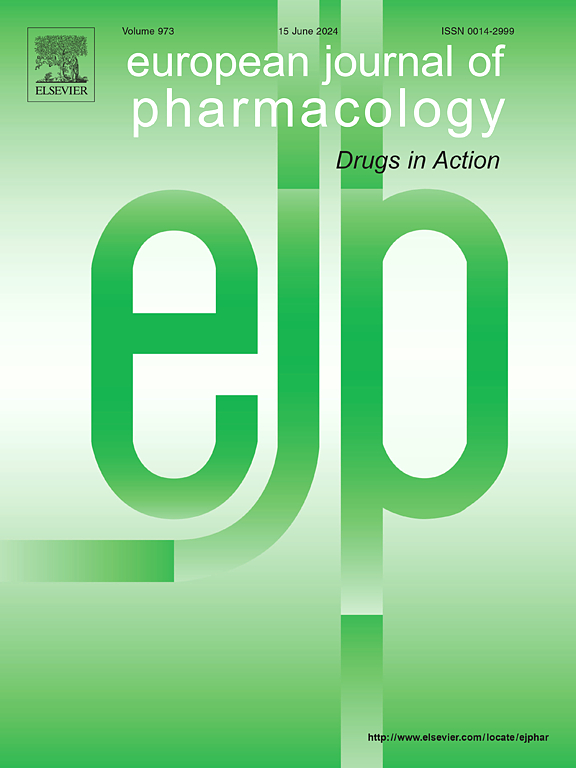HMGB1 derived from macrophages and enteric glial cells contributes to the butyrate-induced colonic hypersensitivity in mice
IF 4.2
3区 医学
Q1 PHARMACOLOGY & PHARMACY
引用次数: 0
Abstract
High mobility group box1 (HMGB1), a nuclear protein, once acetylated by histone acetyltransferase, is released into the extracellular space, and causes pain signals, thereby contributing to pathological pain. Repeated intracolonic administration of butyrate, known to inhibit histone deacetylase (HDAC), produces colonic hypersensitivity in rodents, being widely used as models for irritable bowel syndrome (IBS). Thus, we asked whether HMGB1 would participate in the butyrate-induced colonic hypersensitivity in mice, and analyzed the underlying mechanisms. Repeated butyrate treatment caused colonic hypersensitivity to distension and intraluminal sulfide, a functional enhancer of Cav3.2 channels, in mice, which was prevented by repeated treatment with an anti-HMGB1-neutralizing antibody, thrombomodulin alfa (TMα) capable of causing thrombin-dependent degradation of HMGB1, antagonists for RAGE, TLR4 and CXCR4, membrane receptors of HMGB1, liposomal clodronate, a macrophage depletor, and ethyl pyruvate capable of inhibiting HMGB1 release from macrophages. Butyrate treatment increased the number of Iba1-positive macrophages, but not S100B-positive enteric glial cells (EGCs), and the rate of cytosolic/whole cell HMGB1 levels in both types of cells in the colonic mucosa. In macrophage-like RAW264.7 cells and EGC-like CRL-2690 cells, butyrate as well as trichostatin A, a well-known HDAC inhibitor, at the same concentrations that increased histone acetylation, evoked cytoplasmic translocation and extracellular release of nuclear HMGB1. Together, butyrate is considered to cause HMGB1 release from macrophages and EGCs most probably by inhibiting HDAC, resulting in colonic hypersensitivity in mice. HMGB1 and its membrane receptors might serve as drug targets for colonic hypersensitivity in IBS patients.

来源于巨噬细胞和肠胶质细胞的HMGB1参与丁酸盐诱导的小鼠结肠超敏反应
高迁移率组蛋白1 (HMGB1)是一种核蛋白,一旦被组蛋白乙酰转移酶乙酰化,就会释放到细胞外空间,产生疼痛信号,从而导致病理性疼痛。众所周知,丁酸盐可抑制组蛋白去乙酰化酶(HDAC),在啮齿类动物中引起结肠超敏反应,被广泛用于肠易激综合征(IBS)模型。因此,我们询问HMGB1是否会参与丁酸盐诱导的小鼠结肠超敏反应,并分析其潜在机制。重复丁酸盐治疗引起小鼠结肠对扩张和腔内硫化物(Cav3.2通道的功能增强剂)的超敏反应,可通过抗HMGB1中和抗体、血栓调节蛋白α(能够引起HMGB1凝血酶依赖性降解的TMα)、RAGE、TLR4和CXCR4拮抗剂、HMGB1膜受体、氯膦酸脂体(巨噬细胞消耗剂)、和丙酮酸乙酯能够抑制巨噬细胞释放HMGB1。丁酸盐处理增加了iba1阳性巨噬细胞的数量,但没有增加s100b阳性肠胶质细胞(EGCs)的数量,并增加了结肠粘膜两种细胞中胞浆/全细胞HMGB1水平的比率。在巨噬细胞样RAW264.7细胞和egc样CRL-2690细胞中,丁酸盐和trichostatin A(一种著名的HDAC抑制剂)在相同浓度下增加组蛋白乙酰化,引起细胞质易位和核HMGB1的细胞外释放。综上所述,丁酸盐可能通过抑制HDAC导致巨噬细胞和EGCs释放HMGB1,从而导致小鼠结肠超敏反应。HMGB1及其膜受体可能是IBS患者结肠超敏反应的药物靶点。
本文章由计算机程序翻译,如有差异,请以英文原文为准。
求助全文
约1分钟内获得全文
求助全文
来源期刊
CiteScore
9.00
自引率
0.00%
发文量
572
审稿时长
34 days
期刊介绍:
The European Journal of Pharmacology publishes research papers covering all aspects of experimental pharmacology with focus on the mechanism of action of structurally identified compounds affecting biological systems.
The scope includes:
Behavioural pharmacology
Neuropharmacology and analgesia
Cardiovascular pharmacology
Pulmonary, gastrointestinal and urogenital pharmacology
Endocrine pharmacology
Immunopharmacology and inflammation
Molecular and cellular pharmacology
Regenerative pharmacology
Biologicals and biotherapeutics
Translational pharmacology
Nutriceutical pharmacology.

 求助内容:
求助内容: 应助结果提醒方式:
应助结果提醒方式:


